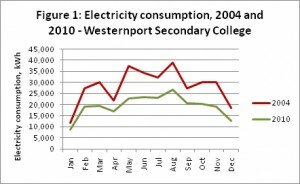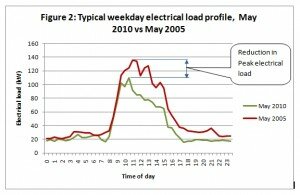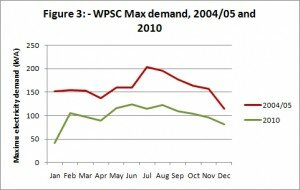Energy efficiency – if you “get it” tell someone!
Tuesday, February 8th, 2011Today’s Financial Review front page news was about the desperate need for more power stations in Australia. The article stated that according to the Australian Energy Market Operator electricity consumption is increasing at 2.5% per year, and we need between 700 and 900 MWh of extra generating capacity per year. And that to cope with increased demand and a carbon price, Australian power generators will have to invest up to $120 billion in new electricity assets over the next 20 years.
These comments, and the failure of the article to mention energy efficiency, clearly show that by and large most people just don’t “get” energy efficiency. Because if as a society we really got energy efficiency, we wouldn’t need any new power stations.
So if you “get” energy efficiency, tell someone. Let me give you some examples of what energy efficiency means:
- A local government client has cut electricity consumption in its office complex by 32% (2010 vs 2006). The office complex contains three major buildings, two of which are over one hundred years old and subject to heritage constraints.
- One of our earliest clients, Westernport Secondary college, used 31% less electricity in 2010 than it did in 2004. Roughly same number of students. Maximum peak demand at the college has also dropped, by39%.
- The all-electric CarbonetiX office uses 35 kWh/m2/year – that’s everything – light, power, heating, cooling. Most comparable offices would use over 100 kWh/m2/year. We are certainly using much less than the previous tenant.
All these examples show what energy efficiency can do to reduce the demand for energy – and cut carbon emissions -whether a building be old or new, owned or leased. And the energy efficiency measures implemented at the local government office, Westernport Secondary College and the CarbonetiX office haven’t been particularly complex or used leading edge technology. In fact some of the savings come not from technology, but from choice. Choosing to switch off, to only switch on when necessary, choosing to change the air conditioner temperature settings, choosing to be conscious of energy usage.
The example of Westernport Secondary College is particularly interesting. If every household and organisation that uses electricity could do what Westernport Secondary College has done we would need about 39% fewer power stations, not more.
I’m not the only one who “gets” it. New Scientist has recently reported on a study by Cambridge University which found that energy efficiency could cut world energy usage by over 70%.
Energy efficiency has multiple benefits:
- It reduces carbon emissions
- It saves money for the energy consumer
- It reduces peak demand
- It reduces upward pressure on electricity prices
So, if you “get” energy efficiency tell someone!







